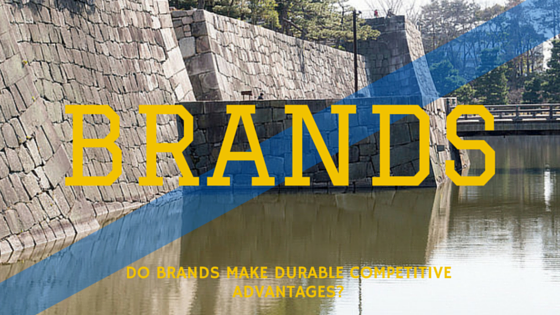The estimated reading time for this post is 4 seconds
Note: Highlight to Tweet is enabled - Just highlight text to easily share the selected content to Twitter!
I’ve decided in the past, that a company’s brand was a strong enough moat to keep competitors at bay, and allow the company to keep earning profits This has been a grave error, and warrants further study. I’ve since learned that a brand, by itself, is not a strong competitive advantage resulting in a defensible economic moat. For a strong moat a stronger situation needs to be in place such as some kind of customer preference, distribution or network effect that is the source of a strong competitive advantage. Companies spend a lot of money on marketing and advertising to build a brand. This usually entails messaging that relates the name of the company or product to some benefit. The goal is to build that association into a customer’s (or potential customer) mind so that it becomes easy to recall in one’s mind at a later time.
What I have discovered over time, and what others have written about, is that a brand, by itself, is easy to replicate by spending money. Any company, with enough cash, can “buy up” to the brands advantage and receive the same value. The only barrier is the needed investment to “buy up” to a similar level. I wish I would have read Value Investing Beyond Buffet by Greenwald earlier than I did to successfully navigate away from making the brand as a moat mistake. It is imperative to further evaluate a company’s situation within the marketplace to decide the competitive situation, and not become lazy and associate the strong brand with a profit advantage. There are only a handful of durable competitive advantages, and not all of them are as strong as the other. Two very strong moats are low-cost producer and a strong network effect. It is very difficult for a competitor to replicate a strong network effect or to become the low-cost producer, it’s easy to replicate a strong brand if given enough money.
- Government Protection – Exclusive Rights
- Cost Advantages (Supply) – Access to limited resources or controlled resources – proprietary technology – Intellectual Property (IP)
- Demand Preferences – High Switching Costs – Customer Captivity
- Economies of Scale (Cost Advantages)
- Access to Superior Information or Technology
So in reality, it is very difficult for a company to build a sustainable advantage which leads to out-sized profits over time. Finding a true advantage leads to truly high profits, and can be a great investment if the price paid is acceptable.
A recent blog posting by Quang over at http://gannonandhoangoninvesting.com/blog/2016/1/16/a-simple-way-to-think-about-moat discusses moats or sustainable competitive advantages of companies.
I’ve recently finished reading Thinking, Fast and Slow by Danial Kahneman and the book discusses how a person’s intuition works in the “fast” part of the brain and this part of the brain is susceptible to branding. Branding is described as just the familiarity within the associative cognition of the brain with an object. In the book, Kanheman discusses priming, which is defined as a method to induce action by an idea which is demonstrated to an unknowing subject. This is how branding works within the marketing and advertising world. Companies spend money to associate the product or service with an idea that will induce an action during the buying process. This is why advertisements (especially in store pop-ups help impulse purchases) and marketing work, they create an association that is later recalled by an individual in which drives an action (buy). Branding is powerful, but it must be understood that a strong brand, by itself, is not a sustainable competitive advantage that can be relied upon to increase profits at an accelerated level for a long period. Competitors will and can attack the brand by spending money and diminish the returns of the company.
I’ve made this mistake in the past by thinking that the strong brand will help reduce other concerns within the market and/or company. Most recently with $LF, I thought because of the strong brand with parents (and especially moms) that the sales will continue to be strong, but this in fact ended with a loss. I sold out before the price hit the lows, but damage was still done. When evaluating brands and companies, make sure to dig deeper for advantages and see if the company has a strong, durable advantage as listed above. If not, the company can be attacked by competitors which will affect the sales and profitability as a going concern. These types of company’s will ultimately just return their cost of capital thus eliminating any benefit of growth going forward.
General Disclaimer
The content contained in this blog represents the opinions of Ray Bonneau and RayBonneau.com. Ray Bonneau or persons posting on RayBonneau.com may hold either long or short positions in securities of various companies discussed in the blog. The commentary in this blog in no way constitutes a solicitation of business or investment advice. Readers should do their own homework and research when making investment decisions. The blog is intended solely for the entertainment of the reader, and the author.
Ray Bonneau is a participant/publisher in certain affiliate programs, including Amazon's Associates Program. Ray Bonneau will earn a small commission when a link to an affiliate site is clicked and a purchase is made. Affiliate programs help Ray Bonneau earn money to pay for this blog. Readers do not pay any extra money when clicking and using affiliate links on RayBonneau.com

